Onions
 Onion in Bloom
Onion in Bloom
TABLE OF CONTENTS
- ONIONS
- GROWING CONDITIONS AND DAY-LENGTH
- SEEDS, STARTS AND SETS
- CURING AND STORAGE
- FLOWERING
- SEED HARVEST
- CHIVES, GREEN AND BUNCHING ONIONS
- WALKING ONIONS
- OTHER THOUGHTS
- RANDOM PICTURES
ONIONS:
It took me a few years to learn how to grow bulbing onions and to get more consistent results. As most are a biennial (taking two years to flower) crop it takes that second season to get the flowering tops (called umbels) as shown above.
There are a lot of different varieties of onions and also different types described by words like: chives, bunching, walking, green, pearl, potato, shallots or bulbs. Each variety or type can need different methods and conditions and then there are some which seem to grow well no matter what I do to them.
I hope I can give enough details to get someone started on the learning journey of growing onions of different types and how to keep growing them from year to year. I can’t cover every variety known or all the types mentioned above (in the case of shallots or potato onions I have no experience with them), but at least I can get you started.
When selecting varieties it is important to pay attention to your soil, your climate, day-length (a bit more on this below) during the longest days of your growing season and how long your season is.
Other considerations with varieties are how large they get and how well they do in storage after curing.
The following picture is an example of a rather large onion we normally grow each season called Kelsae (also called Giant Kelsae or Giant Sweet Kelsae) which is a long day-length onion that takes about 110 days from seed to bulb. It is a bit of a mess of a bulb but you can see they can get pretty big. When cured they are what I would consider a moderately good storage onion but they are not a long storage onion (this is a common trait of sweet onions in that they don’t normally store well for extended periods of time unless conditions are perfect).
Kelsae Onion -
Sep 22 2009 (688K)

GROWING CONDITIONS:
It took me a few years to get the conditions figured out for onion bulbs. Like many garden vegetables they are a full sun loving crop and they do not like to be crowded nor do they like to compete for nutrients, water or light. It is easier to keep onions weeded if there is enough space between them - the larger the expected onion bulb the more room I will give it to grow.
As for the soil conditions they like a higher amount of nutrients than some other garden plants (I treat them the same as tomatoes and the large sweet red peppers). They need regular watering if there are dry spells during their growing season. Irregular watering means the layers within the onion will be of varying sizes which means when cutting up and cooking your home grown onions after harvest you can also evaluate your watering schedule.
How deep you plant is dependent upon the type of onion and if it is a seed, set or a start. I cover this in the below sections on these.
We have mostly clay content soils here so I have to make sure that the onions have enough drainage that they are not sitting in puddles for long spells of time. I amend the soil with worm compost (my main source of nutrients for the more heavy feeding crops I plant). The sulfur content of mostly clay soils may make your onions more pungent - if you are growing sweeter onions put those into the more sandy loamy soils and also do not use fertilizers, composts or amendments with a lot of sulfur (e.g. gypsum and epsom salts both contain sulfur).
These large onions were growing well and you can see that the rows from the seeds I planted in the previous fall are mostly dying back. There were some tiny sprouts of some bunching onions starting up in the foreground.
Onions -
Jul 3 2021 (4297K)

Chives and the other types of onions seem to be more tolerant of conditions and it is hard to get any planting of chives to not be self-crowding and they grow well and are easier to take care of if they are a bigger clump. We’ve had some rather huge patches of chives. You will find bees love them when they flower. I’ve never had problems with chives not getting enough seeds on them - in fact we often end up removing the flowers as they fade before they can drop more seeds around and spread even further.
Chives -
May 16 2012 (1182K)
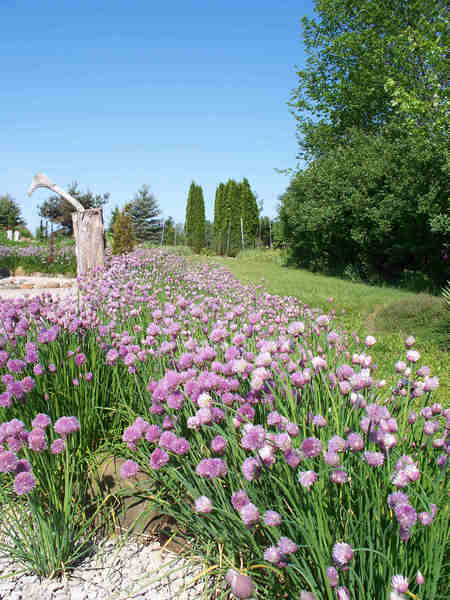
Day-Length
I’ve mentioned day-length being important for some varieties and locations. Day-length sensitive varieties will only form a bulb when the total hours of daylight gets into their range. As an example some onions with a less sensitive day-length may work better when planted in the fall for a late spring harvest. The above mentioned Kelsae onion are a long day-length onion - they will not get as large if grown nearer to the equator as compared to our location here in the north.
SEEDS, STARTS AND SETS:
Working with seeds you can plant them the previous year and grow them until they go into dormancy. Once they’ve died back then they are ready to be lifted and put into storage until you need to plant them out again. Some onions can grow pretty quickly from such sets and you can plant those out in the early spring after the worst of the frosts have gone past and they will get big enough to give a reasonably sized onion bulb by the time of harvest. Other onions may take more than one season to get to a large enough sized bulb.
Onion seeds may take a bit longer to sprout and grow than you would expect (7-15 days depending upon soil temperature). I normally plant them between 2-3cm deep and sprout best when kept evenly moist.
The difference between a start and a set is that a start is an actively growing onion in a small pot or perhaps can even be a small bunch of onion sprouts growing together in a small pot which you’ll need to separate to plant. I just tease them apart and they recover after being watered in. Starts are planted so that the roots of the actively growing plant are covered by 2-3cm of soil and then it is firmed enough to hold the plant in place so the stalks don’t fall over. Water well. The starts that are one plant per cell are easier to handle and don’t suffer as much transplant shock but either method does work. Of course you can grow your own starts.
Because we have limited indoor space I grow sets outdoors, but in either case you can also usually buy them at a garden center or on-line if you want specific varieties and don’t want to go through the other steps needed to get them ready in time for planting out into the garden. Also note there are sometimes small bundles of onions where the roots have been clipped off and they’ve been dried so they would not grow for a while until you plant them out into your garden. I consider these the same as onion sets and plant them the same way as sets.
Onion sets are grown and sold as small bulbs. Each variety can be different, but as you learn you’ll figure out which size is optimal and which ones are too large (which will likely flower). An onion bulb that flowers is not as easily used for cooking because the flower stalk may come up through the onion but parts of what is left after flowering will be edible - just that most people do not want to grow onions for flowers or their seeds. For many varieties the size I start with is about 10-15mm and they’re planted with 2-3cm of soil over the top of them. While it is not normal for onions to flower even from smaller sets it can still happen if your weather changes away from moderate to cold or hot - the changing conditions signal the plant that perhaps it should set seeds as quickly as possible. If that happens the onion is still edible it’s just not quite the bulb shape you expected - eat those first, they won’t store as well.
Here are some pictures of growing onions from seeds to get onion sets and harvested sets and then a picture the next early spring.
I planted two rows of some old onion seeds instead of throwing them away to see how many would grow (I didn’t expect many - wrong!). The left side of the picture are red and reddish onions and the right side were from white and yellow onions. I wondered how many would survive the winter.
Onion Sprouts -
Nov 8 2020 (2106K)
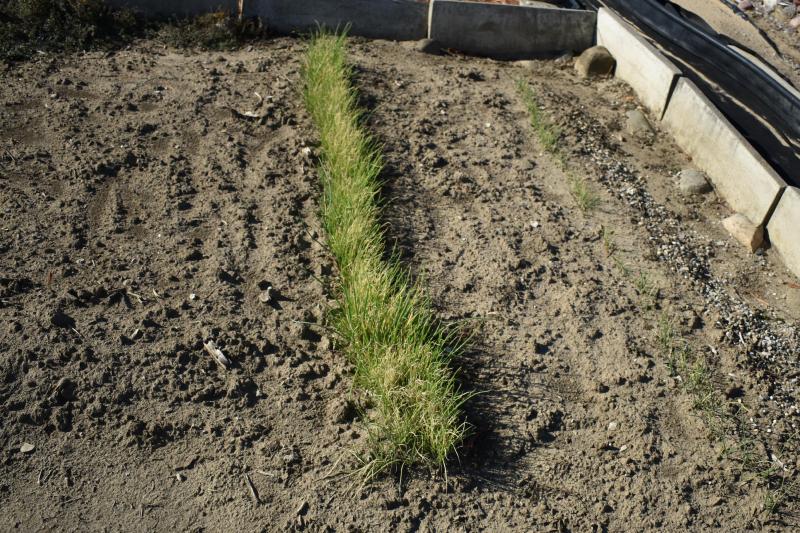
Many of the onion sprouts did survive the winter. The right side row with less sprouts won’t need much thinning but the left row is still pretty thick. When growing starts you don’t need to worry as much about thinning them as compared to if you are trying to grow larger bulbs. I ended up mostly leaving them alone other than keeping them weeded.
Next Spring Onion Sprouts -
Apr 10 2021 (3958K)
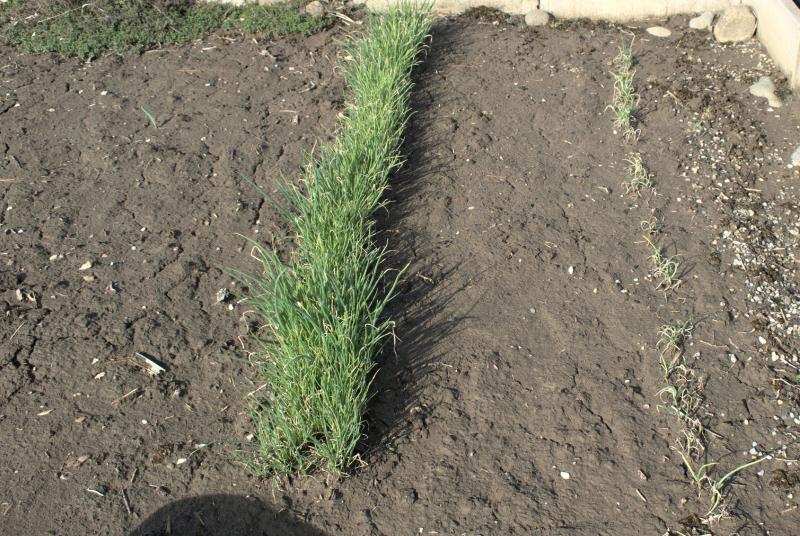
Sets can last quite a long time in proper storage. This bucket of starts was kept in my 18C room for the four months and before that they were kept in the garage until it got too cold and I was worried they would be damaged by freezing - making that 10 months total and they are still in pretty good condition and could be planted at any time in the spring once the worst of the frosts are past and they can also be planted in the fall. I prefer to plant them in the spring.
Onion Sets -
Apr 30 2022 (3626K)
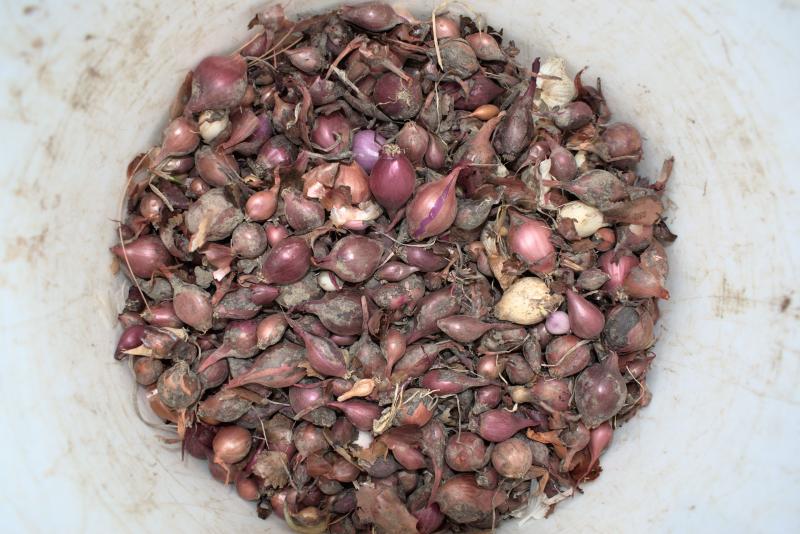
CURING AND STORAGE:
Onion bulbs will start falling over when they begin to be ready for harvest. Some people will knock them all down when half have fallen over. I normally will harvest those that fall over early for eating and using up right away. Once some others have fallen over then lifting the rest and leaving them to dry out if there is no rain in the forecast is ok - turning them to make sure they dry out and don’t start molding. With our climate rains often happen so I do bring them into the garage to finish curing and I make sure to turn them ever day or two to make sure they are not going to start rotting. Once they are cured some will keep longer than others. I make sure they are dry and then they can be stored in a dark, dry and cool location.
Onions and Onion Sets -
Oct 11 2021 (3944K)
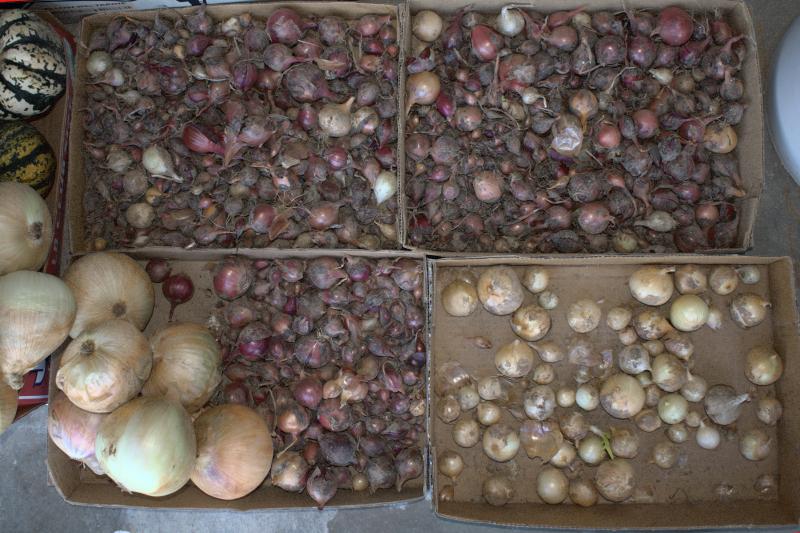
FLOWERING:
The green onions and chives are usually pretty easy to get to flower. The more regular onions grown for bulbs may take a few seasons to figure out. The key to them is picking larger starts, so when figuring out which bulbs to keep for the following spring it is good to set aside some of the larger of the smaller bulbs to plant out in the spring (or you can leave them in the ground and they will start to regrow in the fall and perhaps survive through the winter to flower the following summer).
Onions easily cross pollinate so if you are planning on growing multiple varieties near each other they may easily mix. In order to keep them from crossing you will either have to isolate some blooms so that the bees cannot get at them or use quite a large amount of space (often said to be a kilometer or more). The distance is entirely going to depend upon what kinds of bees you have around and who else might be planting onions. Personally I do not care if the onions I grow cross with each other as they will then give me locally adapted onions in time. I don’t need uniformity or specific colors as long as the onions will grow and finish on time and they can be properly dried and cured for storage.
Selecting for shape, size, color, day-length, etc. to develop your own variety can be a fun project but it is beyond the scope of my own practices to describe how it is done. Given how easily they do cross breed and isolation distances needed it is beyond my own space or desires.
Examples of seeds and a dried top below in walking onions.
SEED HARVEST:
The seeds are best harvested when they just start splitting open the pods but before the pods have started scattering the seeds. This makes it much easier to control your onion patch. I cut the onion flower bunches off with some stalk and then leave them to dry in box tops or shallow flats. Once in a few days I’ll rotate them to make sure they dry well and don’t start spots of fungus - I’ve never actually had fungus start on them before, but it just seems like a good thing to do. A few onion flower tops have tons of seeds. I easily supply all of my onion seed requirements from a handful of flower tops.
Examples of seeds and a dried top below in walking onions.
CHIVES, GREEN AND BUNCHING ONIONS:
These are pretty easy to grow and there are many varieties to pick from.
Chives have a lot of uses as a garnish for many dishes. We’ve had several rather large patches and the bees sure do love them.
Other types of green onions can be grown from planting seeds in the fall or early spring and then harvesting as they grow. Even regular onion seeds planted can be used as green onions where you plant a few extra seeds to start and then thin them as they grow leaving the larger and well spaced plants to finish as bulbs. I normally do not do this, but instead grow specific patches of onion plants for green onions.
Bunching onions and shallots can also be used and each variety may need different techniques but they are all delicious and so useful for cooking plus any that you leave to flower the bees will really enjoy visiting. The fun I have been having with green onions is to find a variety that we like that will also survive our winters with minimal concern.
Here are examples of bunching onions I’ve grown:
Bunching Onions -
Sep 11 2018 (1698K)
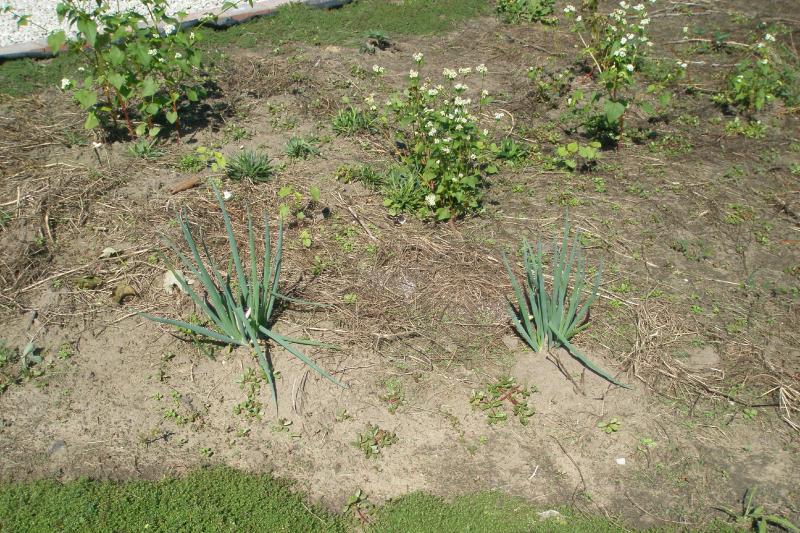
The bumble bees sure enjoy the onion flowers. I’m so glad to see them. :)
Bumble Bees -
Jun 13 2020 (1734K)

The farthest row in the back. It is hard to believe those little sprouts from the previous season did so well and survived our winter without being mulched.
Bunching Onions -
Apr 29 2022 (3834K)
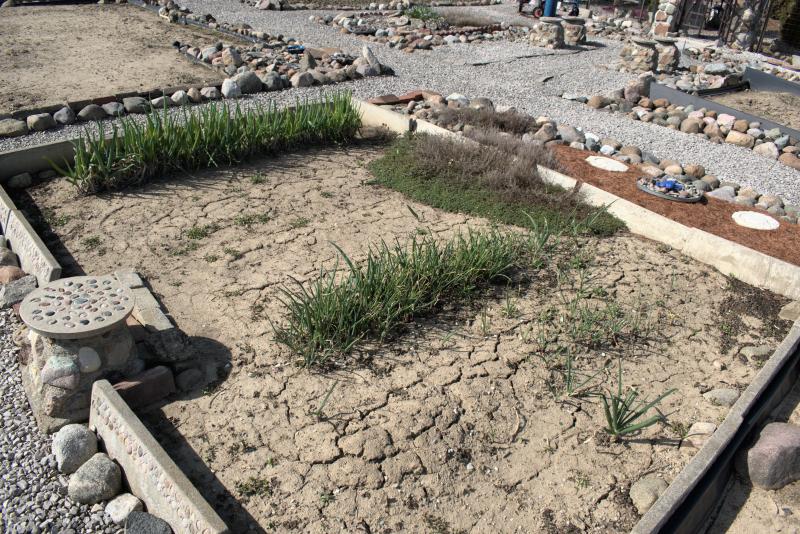
WALKING ONIONS:
A type of onion which gets tiny bulbs on top which can then go on to start growing a new plant after the top has fallen over and reached the ground. In 2021 I had some onion flower tops that had some small bulbs on them along with the seed pods and seeds so of course I will grow them again to see what happens next.
Onion Seeds -
Apr 30 2022 (2674K)

Onion Bulbules -
Apr 30 2022 (3307K)
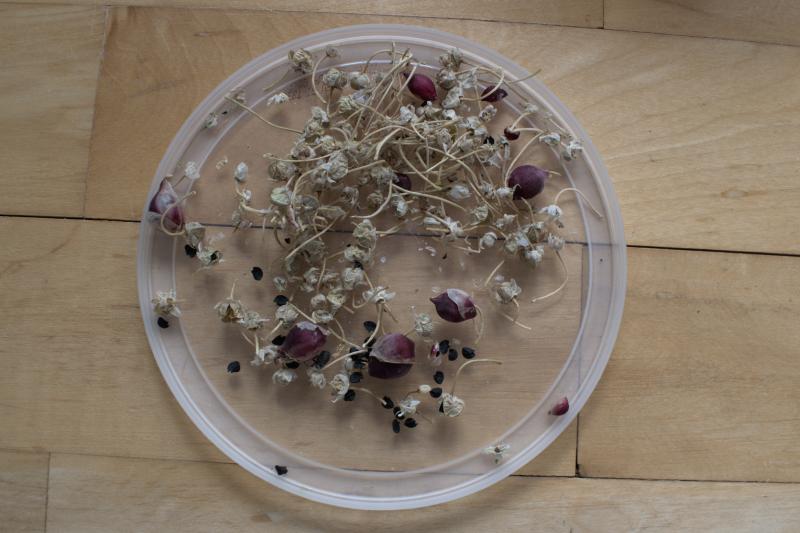
OTHER THOUGHTS:
You may wonder what to do with a lot of small onions or find that you have way too many to plant. In the end all parts of the onion are edible when green and even after things have dried out the husks or stems or anything else are appreciated by worms. When lifting onions from the ground it is very common to find worms hanging out around the roots of onion plants. I’m pretty sure it has a lot to do with the sulfur compounds found in the alliums in general as this also happens with garlic. When I have any left over bits of garlic or onions and feed them to the worms it’s a popular item. Take any scraps out and burying them deeply enough (and you can also put some newspapers or cardboard over them if you’re worried about them regrowing) in a garden and the worms will eventually turn it all into plant food.
The smaller onions not used as sets or for flowering can be used in cooking with a bit more effort and also the smaller onions can be used in pickling or even making relishes. I’ve used quite a few over the years just as garnishes for pizzas or other dishes where I just want a bit of onion and didn’t want to chop up a bigger one.
I’ve not ever had much of an issue with insects bothering the onion plantings here.
I have had issues with raccoons coming along and uprooting onion starts purchased from the greenhouse because some places use fish-emulsion fertilizers and the raccoons think there is something edible down there and so they dig them up.
I think the hardest issues I’ve had to figure out were spacing, regular watering and having enough nutrients to get the bulbs to grow large enough.
RANDOM PICTURES:
Sometimes I just want a place to put an onion picture - this is it…
The mid-spring onion patch picture showing most of them. You can see that they have survived and are growing ok. The bunching onions on the left you can not see much of but enough of them survived. No weeding or cleanup done yet. Some will be thinned out and eaten as green onions.
Onion Patch -
Apr 15 2023 (4263K)
